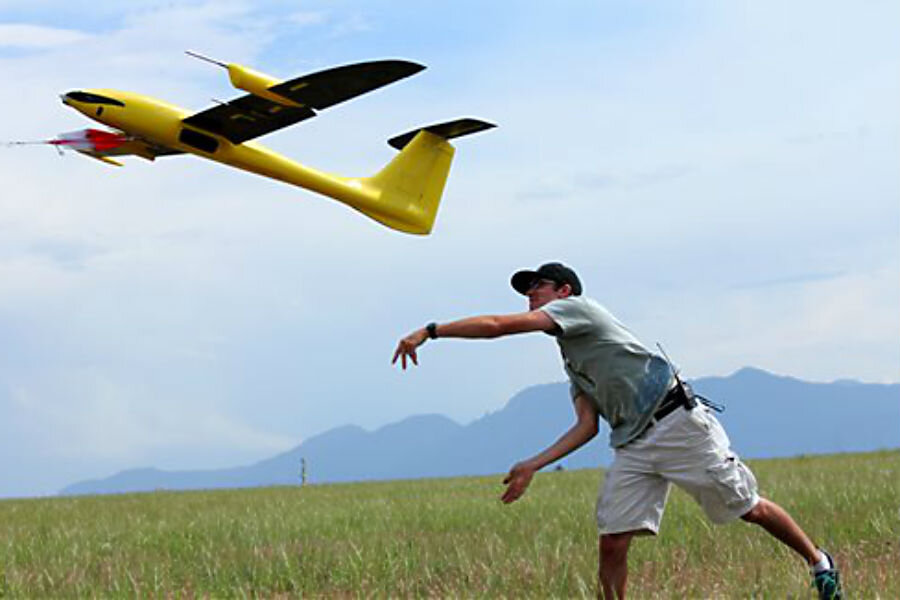What drones can teach us about tornadoes
Loading...
| Denver
Researchers say they've collected promising weather data by flying instrument-laden drones into big Western and Midwestern storms. Now they want to expand the project in hopes of learning more about how tornados form.
Drones can penetrate parts of weather systems that other instruments can't reach, and they can do it at less cost and with less danger than piloted planes, the scientists say.
The University of Colorado and University of Nebraska announced this week they have formed the Unmanned Aircraft System and Severe Storms Research Group to develop the program.
Here are some key questions and answers about the research:
WHY USE DRONES?
Scientists have no other way to get instruments deep inside a storm. Drones can take measurements at any altitude up to about 2,500 feet — higher than measurements by ground stations and storm-chasing vehicles, said Adam Houston of the University of Nebraska-Lincoln, co-director of the research group. They can also measure wind below 300 feet, lower than radar can reach. Drones can cover more territory than a ground-based storm chaser, and they don't need an airport to take off or land. A drone can fly into the strong winds, downdrafts, rain and hail of a powerful storm without putting a human pilot in danger.
DON'T THEY CRASH?
So far, none of the drones have crashed during storm research, but if the scientists launch a more intensive program with more flights, crashes become more likely, said Eric Frew, director of the University of Colorado's Research & Engineering Center for Unmanned Vehicles and a member of the Severe Storms Research Group.
WHAT KIND OF DRONES?
The aircraft are about 5 feet long and have a wingspan of about 10½ feet. They carry instruments to measure temperature, moisture and wind direction and speed, transmitting data to researchers on the ground via Wi-Fi and also storing it onboard. Including instruments, autopilot and communications gear, they cost $30,000 to $50,000 each. Making them storm-worthy increases the cost above other research drones, but piloted aircraft would cost hundreds of thousands of dollars, the researchers said.
WHAT DO RESEARCHERS LEARN?
Researchers try to fly the drones into supercell thunderstorms, which create tornados, but not into tornadoes themselves. The measurements taken inside a storm provide a "fingerprint" that can tell where the air inside a storm came from and what forced it there, Houston said. If that air becomes part of a tornado, the fingerprint can help researchers learn how the twister formed. The researchers also want to know if that information could help forecasters predict tornados.
WHAT HAVE THEY ALREADY DONE?
Colorado and Nebraska researchers have flown drones into about 10 storms, including six supercell thunderstorms, since 2009. "Funding agencies didn't believe we could do it," Frew said. "We demonstrated that we could do it." The temperature and moisture data from those flights were good, but the wind measurements proved trickier, Houston said, and researchers are working on ways to improve them.
WHAT'S NEXT?
The team is looking for a government research grant of $1 million to $1.5 million for a two- or three-year project. They would make multiple trips into storm country during the May-June tornado season and then analyze the data.
WHERE WOULD THE DRONES FLY?
The scientists currently have Federal Aviation Administration clearance to fly in 47,000 square miles over parts of Colorado, Kansas, Nebraska and Wyoming, Frew said. They're seeking FAA authorization for parts of Oklahoma and Texas, which would add about 47,000 square miles more.
HOW ARE DRONES USED IN OTHER RESEARCH?
More scientists are utilizing using drones to gather data, Frew said. University of Colorado drones have been used to measure atmospheric temperatures and cloud chemical composition in the Arctic. The university will also use drones to measure turbulence, temperature and other data in the wake of wind turbines. Other researchers use them to check crop health and soil moisture on farms.
___
Unmanned Aircraft System and Severe Storms Research Group: http://ussrg.unl.edu/
___
Follow Dan Elliott at http://twitter.com/DanElliottAP







